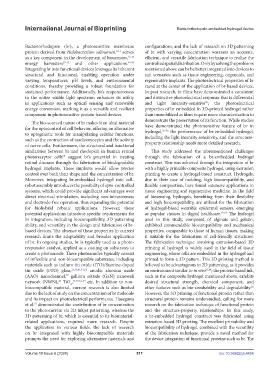Page 525 - IJB-10-6
P. 525
International Journal of Bioprinting Bacteriorhodopsin-embedded hydrogel device
Bacteriorhodopsin (br), a photosensitive membrane configurations, and the lack of research on 3D patterning
protein derived from Halobacterium salinarum, 6-13 serves of br with varying concentration warrants an accurate,
as a key component in the development of biosensors, 14-26 efficient, and versatile fabrication technique to realize the
energy harvesters 27-43 and other applications. 44-49 controlled spatial distribution. Only by solving the problems
Integrating br into functional devices leverages its inherent mentioned above can br be better integrated into devices to
structural and functional, enabling operation under suit scenarios such as tissue engineering, organoids, and
varying temperatures, pH levels, and environmental regenerative implants. The photoelectrical properties of br
conditions, thereby providing a robust foundation for stand at the center of the application of br-based devices.
sustained performance. Additionally, br’s responsiveness In past research, br films have demonstrated a consistent
to the entire visible light spectrum enhances its utility and distinctive photoelectrical response that is differential
55
in applications such as optical sensing and renewable and light intensity-sensitive ; the photoelectrical
energy conversion, marking it as a versatile and resilient properties of br embedded in 3D-printed hydrogel rather
component in photosensitive protein-based devices. than immobilized as films require more characterization to
The bio-sourced nature of br makes it an ideal material demonstrate the preservation of its function. While studies
for the optocontrol of cell behavior, offering an alternative have demonstrated the photosensitive feature of br in
56-58
to optogenetic tools for manipulating cellular functions, hydrogel, the performance of br-embedded hydrogel,
such as the contraction of cardiomyocytes and the activity including the light intensity sensitivity, and the structure-
of nerve cells. Furthermore, the structural and functional property relationship needs more detailed research.
similarities between br and rhodopsin in human retinal This study addressed the aforementioned challenges
50
photoreceptor cells suggest br’s potential in treating through the fabrication of a br-embedded hydrogel
retinal diseases through the fabrication of biodegradable construct. This was achieved through the integration of br
hydrogel implants. These implants would allow precise with a highly printable composite hydrogel, using extrusion
control over both their shape and the concentration of br. printing to create a hydrogel-based construct. Hydrogels,
Moreover, integrating br-embedded hydrogel into cell- due to their ease of molding, high biocompatibility, and
robot assembly introduces the possibility of opto-controlled flexible composition, have found extensive applications in
systems, which could provide significant advantages over tissue engineering and regenerative medicine. In the field
direct electrical stimulation, including non-intrusiveness of biosensing, hydrogels, benefiting from their flexibility
and electrode-free operation, thus expanding the potential and high biocompatibility, are utilized for the fabrication
for biohybrid robotic applications. However, these of hydrogel-based wearable epidermal sensors, emerging
potential applications introduce specific requirements for as popular choices in digital healthcare. 59-62 The hydrogel
br integration, including biocompatibility, 3D patterning used in this study, composed of alginate and gelatin,
ability, and versatility in the design and fabrication of br- exhibited commendable biocompatibility and mechanical
based devices. The absence of these properties in current properties, comparable to those of human tissues, making
research limits the adaptability and broader application it suitable for the fabrication of cell-friendly structures.
of br. In ongoing studies, br is typically used as a photo- The fabrication technique involving extrusion-based 3D
responsive catalyst, applied as a coating on substrates to printing of hydrogel is widely used in the field of tissue
create a photoanode. These photoanodes typically consist engineering, where cells are embedded in the hydrogel and
of inflexible and non-biocompatible substrates, including printed to form a 3D pattern. This 3D printing method is
materials such as indium tin oxide (ITO)/fluorine-doped believed to be advantageous to 2D patterning, as it provides
tin oxide (FTO) glass, 21,30,41,51,52 anodic alumina oxide an environment similar to in vivo 63,64 ; the protein-based ink,
(AAO) nanochannel, gallium nitride (GaN) nanowall such as the composite hydrogel mentioned above, exhibits
37
network (NWN), TiO , 31,35,51-54 etc. In addition to non- desired structural strength, chemical component, and
28
2
biocompatible material, current research is also limited other features such as bio-combability and degradability.
60
due to the lack of study on the concentration of br molecule However, the 3D printing of functional protein rather than
and its impact on photoelectrical performance. Hasegawa structural protein remains understudied, calling for more
19
et al. demonstrated the contribution of br concentration research on the fabrication technique of functional protein
to the photocurrent via 2D inkjet patterning, whereas the and the structure-property relationships. In this study,
3D patterning of br, which is essential to its biomaterial- a br-embedded hydrogel construct was fabricated using
related applications, required more research. Despite extrusion-based 3D printing. The excellent printability and
the application in various fields, the lack of research biocompatibility of hydrogel, combined with the versatility
on br integrated with highly biocompatible materials of the fabrication technique, provide a novel method for
prompts the need for exploring alternative materials and the device integration of functional proteins such as br. The
Volume 10 Issue 6 (2024) 517 doi: 10.36922/ijb.4454

